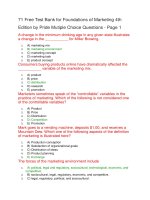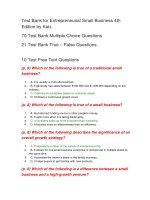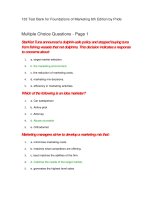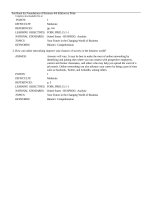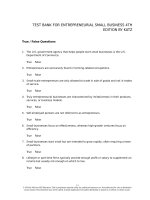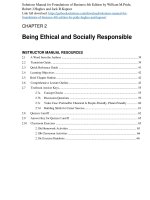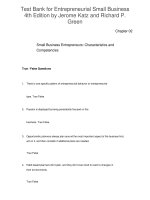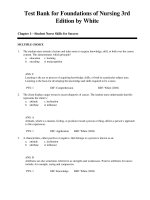Test bank for foundations of business 4th edition by pride
Bạn đang xem bản rút gọn của tài liệu. Xem và tải ngay bản đầy đủ của tài liệu tại đây (441.05 KB, 122 trang )
Test Bank for Foundations of Business 4th Edition by Pride
Complete downloadable file at:
POINTS:
DIFFICULTY:
REFERENCES:
LEARNING OBJECTIVES:
NATIONAL STANDARDS:
TOPICS:
KEYWORDS:
1
Moderate
pp. 4-6
FOBU.PRID.15.1-1
United States - BUSPROG: Analytic
Your Future in the Changing World of Business
Bloom's: Comprehension
2. How can online networking improve your chances of success in the business world?
ANSWER:
Answers will vary. It may be best to make the most of online networking by
identifying and joining sites where you can connect with prospective employers,
current and former classmates, and others who may help you spread the word of a
job search. Online networking can also advance your career by being a part of sites
such as Facebook, Twitter, and LinkedIn, among others.
POINTS:
1
DIFFICULTY:
Moderate
REFERENCES:
p. 5
LEARNING OBJECTIVES: FOBU.PRID.15.1-1
NATIONAL STANDARDS: United States - BUSPROG: Analytic
TOPICS:
Your Future in the Changing World of Business
KEYWORDS:
Bloom's: Comprehension
3. An entrepreneur combines four kinds of resources into a business. What would be the effect on the business if any
one were left out?
ANSWER:
The four kinds of resources include material resources (raw materials), human
resources (people), financial resources (capital and money), and informational
resources (information to make decisions and to evaluate a firm’s activities). Every
business must work to organize these four resources. If one resource is not available
or is left out, the business will, most likely, fail since it is the combination and
balancing of the four resources that creates business success. For example, a
manufacturer cannot produce products if there are no raw materials. And the other
three resources are just as important.
POINTS:
DIFFICULTY:
REFERENCES:
LEARNING OBJECTIVES:
1
Moderate
p. 8
FOBU.PRID.15.1-2
NATIONAL STANDARDS: United States - BUSPROG: Analytic
TOPICS:
Business: A Definition
KEYWORDS:
Bloom's: Comprehension
4. What is profit and why is it important to a business?
ANSWER:
Profit is what remains after all business expenses have been deducted from sales
revenue. Sales revenue is the money received from customers in exchange for goods
or services. In addition, all businesses have expenses which are deducted from
revenue, thus, leaving the profit. A negative profit, called a loss, cannot be sustained
long term for a business to survive. If a firm is operating at a loss, management must
take action to eliminate the loss, increase sales, and reduce expenses or the firm may
be forced to file for bankruptcy protection or go out of business.
POINTS:
1
DIFFICULTY:
Moderate
REFERENCES:
pp. 9-10
LEARNING OBJECTIVES: FOBU.PRID.15.1-2
NATIONAL STANDARDS: United States - BUSPROG: Analytic
TOPICS:
Business: A Definition
KEYWORDS:
Bloom's: Comprehension
5. What three activities must a business perform in order to be successful? Briefly describe each of these and why
each is essential to business success.
ANSWER:
A business is the organized effort of individuals to produce and sell, for a profit, the
goods and services that satisfy society’s needs. For a business to be successful, it
must (1) be organized; (2) make a profit on the goods or services it sells to its
customers; and (3) meet the needs of its customers. If one or more of the three
elements is missing, the business will not be a success.
POINTS:
DIFFICULTY:
REFERENCES:
LEARNING OBJECTIVES:
NATIONAL STANDARDS:
TOPICS:
KEYWORDS:
1
Moderate
p. 8
FOBU.PRID.15.1-2
United States - BUSPROG: Analytic
Business: A Definition
Bloom's: Comprehension
6. Explain how the notion of scarcity is related to personal as well as business decision making.
ANSWER:
Answers will vary. Scarcity refers to the lack of resources—money, time, natural
resources, etc.—that are needed to satisfy a want or need. Because resources are
always scarce, businesses as well as individuals must make decisions based on
resource availability. Personal decisions such as whether to buy a $5,000 used car
versus a $18,500 new car are usually driven by the scarcity of resources and the
ability to pay based on the scarcity. Business decisions are similar.
POINTS:
1
DIFFICULTY:
Challenging
REFERENCES:
p. 11
LEARNING OBJECTIVES: FOBU.PRID.15.1-3
NATIONAL STANDARDS: United States - AACSB: Reflective Thinking
TOPICS:
Types of Economic Systems
KEYWORDS:
Bloom's: Application
7. Explain how the basic economic questions are answered in capitalistic and command economies.
ANSWER:
The four basic economic questions are (1) what goods and services will be produced;
(2) how will they be produced; (3) for whom will they be produced; and (4) who
controls the factors of production. In a capitalistic economy, supply and demand is
primarily driven by the market and what price a product or service will bring. In a
capitalistic economy, businesses and individuals answer the four basic economic
questions. In a command economy, the government decides what goods and services
will be produced, how they will be produced, and at what price they will be offered.
POINTS:
DIFFICULTY:
REFERENCES:
LEARNING OBJECTIVES:
NATIONAL STANDARDS:
TOPICS:
KEYWORDS:
1
Challenging
pp. 11-15
FOBU.PRID.15.1-3
United States - AACSB: Reflective Thinking
Types of Economic Systems
Bloom's: Analysis
8. Why do we say that the U.S. economy is a mixed economy?
ANSWER:
The United States economy exhibits elements of both capitalism and socialism, and,
therefore, can be deemed a mixed economy. The U.S. government, for example,
participates in the economy as more than simply an umpire or rule maker. The U.S.
government participates in the four basic economic questions—what, how, for whom,
and who. For example, the government is involved in public schools, social services
including subsidized childcare or job-search assistance, and public-private partnerships
such as with hospitals or research institutes.
POINTS:
1
DIFFICULTY:
Moderate
REFERENCES:
p. 13
LEARNING OBJECTIVES: FOBU.PRID.15.1-3
NATIONAL STANDARDS: United States - BUSPROG: Analytic
TOPICS:
Types of Economic Systems
KEYWORDS:
Bloom's: Comprehension
9. How does socialism differ from communism?
ANSWER:
In a socialist economy, the key industries are owned and controlled by the
government. Private ownership of smaller businesses is often permitted in socialist
economies. In a communist society, all workers contribute to the economy through
government ownership, and management. In a communist economy, the four basic
economic questions—what, how, for whom, and who—are answered through
centralized government plans.
POINTS:
1
DIFFICULTY:
Challenging
REFERENCES:
pp. 14-15
LEARNING OBJECTIVES: FOBU.PRID.15.1-3
NATIONAL STANDARDS: United States - AACSB: Reflective Thinking
TOPICS:
Types of Economic Systems
KEYWORDS:
Bloom's: Analysis
10. Why is productivity important? How can a nation's productivity rate be improved?
ANSWER:
Productivity is the average level of output per worker per hour. An increase in
productivity results in economic growth because a larger number of goods and
services are produced by the labor force. Increased productivity growth helps an
economy’s businesses to compete more effectively in the global environment due to
more goods or services being produced at a lower cost. Productivity rates can be
improved through technology, advanced employee training, as well as transferring
routine functions to other locations, possibly through the Internet.
POINTS:
1
DIFFICULTY:
Moderate
REFERENCES:
pp. 15-16
LEARNING OBJECTIVES: FOBU.PRID.15.1-4
NATIONAL STANDARDS: United States - BUSPROG: Analytic
TOPICS:
Measuring Economic Performance
KEYWORDS:
Bloom's: Comprehension
11. A nation's economy fluctuates instead of growing at a steady pace every year. These fluctuations are generally
referred to as the business cycle. Describe the four different phases of the business cycle.
ANSWER:
The business cycle generally includes four phases: the peak, sometimes called
prosperity; recession, two or more consecutive three-month periods of decline in a
country’s GDP; the trough, the turning point when a nation’s production and
employment bottom out and reach their lowest levels; and recovery, sometimes called
expansion.
POINTS:
1
DIFFICULTY:
Moderate
REFERENCES:
pp. 17-19
LEARNING OBJECTIVES: FOBU.PRID.15.1-4
NATIONAL STANDARDS: United States - BUSPROG: Analytic
TOPICS:
Measuring Economic Performance
KEYWORDS:
Bloom's: Comprehension
12. What is the difference between monetary policies and fiscal policies? How does each affect the nation's economy?
ANSWER:
Monetary policies are the Federal Reserve’s decisions that determine the size of the
supply of money in a nation and interest rate levels. Fiscal policy is determined by
government’s influence in the amount of savings and expenditures of individuals,
businesses, and government by altering the tax structure and changing the levels of
government spending. Some experts believe that effective use of monetary and fiscal
policies can speed up recovery and reduce the amount of time the economy is in
recession.
POINTS:
1
DIFFICULTY:
Challenging
REFERENCES:
p. 18-19
LEARNING OBJECTIVES: FOBU.PRID.15.1-5
NATIONAL STANDARDS: United States - AACSB: Reflective Thinking
TOPICS:
The Business Cycle
KEYWORDS:
Bloom's: Analysis
13. In perfect competition, who sets the price of a product?
ANSWER:
In perfect competition, there are many buyers and sellers of a product or service and
no single buyer or seller is powerful enough to affect prices. Therefore, the actions of
buyers sets the price of a product since, in theory, all products are the same and
buyers will pay the lowest price for the same products.
POINTS:
1
DIFFICULTY:
Moderate
REFERENCES:
pp. 19-20
LEARNING OBJECTIVES: FOBU.PRID.15.1-6
NATIONAL STANDARDS: United States - BUSPROG: Analytic
TOPICS:
Types of Competition
KEYWORDS:
Bloom's: Comprehension
14. Describe how supply and demand affect the price of a product.
ANSWER:
The supply of a product is the quantity of the product that producers are willing to sell
at each of various prices. Suppliers supply more product when consumers are willing
to pay a higher price. The demand for a product is the quantity that buyers are willing
to purchase at various prices. Buyers demand more when a price is low. Shifts in
demand for a product raise and lower the market price. Also, a change in the supply
of a product can cause a change in the price for the product.
POINTS:
1
DIFFICULTY:
Moderate
REFERENCES:
pp. 20-21
LEARNING OBJECTIVES: FOBU.PRID.15.1-6
NATIONAL STANDARDS: United States - BUSPROG: Analytic
TOPICS:
Types of Competition
KEYWORDS:
Bloom's: Comprehension
15. In a monopolistic competition setting, how can a manufacturer differentiate a product?
ANSWER:
Sellers attempt to differentiate their product or service so it is attractive to consumers.
Product differentiation is the process of developing and promoting differences
between one’s products and all competitive products. For example, sellers provide
unique product features, attention-getting brand or product names, unique and
attractive packaging, and services such as free delivery or a lifetime warranty.
POINTS:
1
DIFFICULTY:
Moderate
REFERENCES:
p. 21
LEARNING OBJECTIVES: FOBU.PRID.15.1-6
NATIONAL STANDARDS: United States - BUSPROG: Analytic
TOPICS:
Types of Competition
KEYWORDS:
Bloom's: Comprehension
16. How does a monopoly have complete control over the price of its product?
ANSWER:
A monopoly has some control over the price of its product because it is the only firm
in the industry. No firm, however, can set its price at some astronomical figure simply
due to lack of competition. The firm would find that no customers would be willing to
pay an exorbitant price. Therefore, the firm in a monopoly position must consider the
demand for its product and set the price at the most profitable level.
POINTS:
1
DIFFICULTY:
Moderate
REFERENCES:
p. 22
LEARNING OBJECTIVES: FOBU.PRID.15.1-6
NATIONAL STANDARDS: United States - BUSPROG: Analytic
TOPICS:
Types of Competition
KEYWORDS:
Bloom's: Comprehension
17. What effect did the Industrial Revolution and the golden age of invention have on the development of American
business?
ANSWER:
In the late 1700s, the factory system of manufacturing was born in which all
materials, machinery, and workers required to manufacture a product were assembled
in one place. Specialization was also introduced during the Industrial Revolution.
Specialization is the separation of a manufacturing process into distinct tasks and the
assignment of different tasks to different individuals. The years of 1820 to 1900 were
considered the golden age of invention and innovation in machinery. Many basic
characteristics of the modern business system took form during these time periods.
POINTS:
1
DIFFICULTY:
Moderate
REFERENCES:
p. 22-24
LEARNING OBJECTIVES: FOBU.PRID.15.1-7
NATIONAL STANDARDS: United States - BUSPROG: Analytic
TOPICS:
American Business Today
KEYWORDS:
Bloom's: Comprehension
18. What do you consider the most important challenges that American business faces today?
ANSWER:
Student answers will vary. The need to create a stable economy with the creation of
new jobs will likely be a continual challenge for the U.S. Regulation of banks, savings
and loan associations, credit unions, and other financial institutions to prevent abuse
will continue to be a challenge. Other challenges include reducing national debt,
defeating terrorism, and resolving conflict with other countries. Using technology to
make workers more productive and competitive, preserving small business benefits in
a global environment, balancing economic growth with sustainability, and meeting the
needs of two-income families, single parents, older Americans, and the less fortunate
will also continue to challenge American business.
POINTS:
1
REFERENCES:
p. 28
LEARNING OBJECTIVES: FOBU.PRID.15.1-7
NATIONAL STANDARDS: United States - AACSB: Reflective Thinking
TOPICS:
American Business Today
KEYWORDS:
Bloom's: Evaluation
Satellite Communications
Jonathan worked for Satellite Communications for twenty years. In the time that he worked there, he learned a lot
about the company and how it operated. The company met its sales and revenue goals every year. However, most
of the employees had similar educational and cultural backgrounds. He believed that the company could do much
better if it cultivated an environment that promoted many different ideas. Additionally, Satellite Communications
was mostly focused on how much revenue it earned in a given year. Jonathan felt that the most important goal
should be to satisfy customers. He believed financial success would result from focusing on customers.
After a lot of consideration, Jonathan decided to open his own business called Universal Communications and hire
employees that reflected a more diverse customer base. He was happy to have this opportunity because it was a
dream that he had always had. He had always wanted to make his own decisions about what his company would
produce and how. The only aspect of the business he was unsure of was pricing, yet he knew this would be
important for his ultimate success.
19. Refer to Satellite Communications. Jonathan is operating in a
and how to do things.
a. command economy
b. mixed environment
c. market economy
d. split economy
because he has the opportunity to decide what
e. micro-economy
ANSWER:
POINTS:
DIFFICULTY:
REFERENCES:
LEARNING OBJECTIVES:
NATIONAL STANDARDS:
TOPICS:
KEYWORDS:
c
1
Moderate
p. 3
FOBU.PRID.15.1-1
United States - AACSB: Reflective Thinking
Your Future in the Changing World of Business
Bloom's: Application
20. Refer to Satellite Communications. When hiring people, Jonathan thinks it is important to consider
a. unilateral thinking.
b. profit.
c. wage increases.
d. health benefits.
e. cultural diversity.
ANSWER:
POINTS:
DIFFICULTY:
REFERENCES:
LEARNING OBJECTIVES:
NATIONAL STANDARDS:
TOPICS:
KEYWORDS:
e
1
Easy
p. 5
FOBU.PRID.15.1-1
United States - BUSPROG: Analytic
Your Future in the Changing World of Business
Bloom's: Knowledge
21. Refer to Satellite Communications. Now that Jonathan plans to open his own business, he needs to look at the
factors of production. Which of the following is not a factor of production?
a. Labor
b. Capital
c. Machinery
d. Demand
e. Entrepreneurship
ANSWER:
POINTS:
DIFFICULTY:
REFERENCES:
LEARNING OBJECTIVES:
NATIONAL STANDARDS:
TOPICS:
KEYWORDS:
d
1
Easy
p. 11
FOBU.PRID.15.1-3
United States - BUSPROG: Analytic
Types of Economic Systems
Bloom's: Knowledge
22. Refer to Satellite Communications. Jonathan's success will contribute to society. This is referred to as the
a. objective.
b. market economy.
c. business cycle.
d. invisible hand.
e. standard of living.
ANSWER:
POINTS:
DIFFICULTY:
REFERENCES:
LEARNING OBJECTIVES:
NATIONAL STANDARDS:
TOPICS:
KEYWORDS:
d
1
Moderate
p. 12
FOBU.PRID.15.1-3
United States - AACSB: Reflective Thinking
Types of Economic Systems
Bloom's: Application
Home Inspirations
Hailey works for her father in a family-owned business called Home Inspirations, a bedding company that has been
in operation since the 1800s. When her father retires, Hailey plans on taking over the business. Hailey is aware of
many things about the company that she likes, and a few things that she does not. She has particularly noted that
when the economy has low unemployment and high total income, sales are great. However, any other time, sales
are not so good.
Currently, all of the bedding items are created in one place and everyone works on various tasks every day. Hailey
is thinking about streamlining the production process so that individuals would be responsible for only one task. She
believes that if production would increase, she could sell her products at a lower price and increase revenue. She
knows that most bedding products available in the market are very similar in nature and satisfy the same need.
However, if she were able to lower prices, this might give her company the competitive advantage that it needs.
She would then be able to invest money in differentiating her products by providing unique features, building the
brand name, and offering services such as free delivery. She is also considering selling her products on the Internet.
Hailey knows that her father does not like change very much, but she feels these changes are important for the
future of the company.
23. Refer to Home Inspirations. Hailey noticed that when sales were up, the economy was in a
a. depression.
b. peak period.
c. grace period.
d. recession.
e. stagnant mode.
ANSWER:
POINTS:
DIFFICULTY:
REFERENCES:
LEARNING OBJECTIVES:
NATIONAL STANDARDS:
TOPICS:
KEYWORDS:
b
1
Moderate
p. 18
FOBU.PRID.15.1-5
United States - AACSB: Reflective Thinking
The Business Cycle
Bloom's: Application
24. Refer to Home Inspirations. Home Inspirations currently operates in a
a. purely competitive
b. demand
c. monopolistically competitive
d. command
environment.
e. supply
ANSWER:
POINTS:
DIFFICULTY:
REFERENCES:
LEARNING OBJECTIVES:
NATIONAL STANDARDS:
TOPICS:
KEYWORDS:
c
1
Moderate
p. 22
FOBU.PRID.15.1-6
United States - AACSB: Reflective Thinking
Types of Competition
Bloom's: Application
25. Refer to Home Inspirations. Hailey feels that for productivity to improve, the company must practice
a. free enterprise.
b. work ethics.
c. specialization.
d. cultural diversity.
e. pure competition.
ANSWER:
POINTS:
DIFFICULTY:
REFERENCES:
LEARNING OBJECTIVES:
NATIONAL STANDARDS:
TOPICS:
KEYWORDS:
c
1
Easy
p. 23
FOBU.PRID.15.1-7
United States - BUSPROG: Analytic
American Business Today
Bloom's: Knowledge
26. Refer to Home Inspirations. Hailey's goal of offering products with unique features and special services is called
a. specialization.
b. product differentiation.
c. barter.
d. a factory system.
e. a natural monopoly.
ANSWER:
POINTS:
DIFFICULTY:
REFERENCES:
LEARNING OBJECTIVES:
NATIONAL STANDARDS:
TOPICS:
KEYWORDS:
b
1
Easy
p. 21
FOBU.PRID.15.1-6
United States - AACSB: Reflective Thinking
Types of Competition
Bloom's: Application
27. When an individual chooses his or her ideal career, it is most likely a reflection of one's
a. values.
b. hobbies.
c. skills.
d. education.
e. desire to be rich.
ANSWER:
POINTS:
DIFFICULTY:
REFERENCES:
LEARNING OBJECTIVES:
NATIONAL STANDARDS:
TOPICS:
KEYWORDS:
a
1
Easy
p. 5
FOBU.PRID.15.1-1
United States - BUSPROG: Analytic
Your Future in the Changing World of Business
Bloom's: Knowledge
28. Chris chooses to work only thirty hours a week as an engineering assistant while trying to shield himself from
additional responsibilities at work. Chris seems to value
a. recognition and rewards.
b. the opportunity to help others.
c. promotions and transfers.
d. more free time.
e. get-rich-quick schemes.
ANSWER:
POINTS:
DIFFICULTY:
REFERENCES:
LEARNING OBJECTIVES:
NATIONAL STANDARDS:
TOPICS:
KEYWORDS:
d
1
Moderate
p. 5
FOBU.PRID.15.1-1
United States - AACSB: Reflective Thinking
Your Future in the Changing World of Business
Bloom's: Application
29. Of the following, which is not considered a basic management function necessary to be an effective manager?
a. Planning
b. Organizing
c. Leading and motivating
d. Controlling
e. Selling
ANSWER:
POINTS:
DIFFICULTY:
REFERENCES:
LEARNING OBJECTIVES:
NATIONAL STANDARDS:
TOPICS:
KEYWORDS:
e
1
Easy
p. 6
FOBU.PRID.15.1-1
United States - BUSPROG: Analytic
Your Future in the Changing World of Business
Bloom's: Knowledge
30. Cultural diversity represents
a. a business theory that is no longer valid.
b. the differences among people in a workforce.
c. a technical skill.
d. a statistical method used to project sales revenues and profits for global companies.
e. a religious issue that doesn't affect business organizations.
ANSWER:
POINTS:
DIFFICULTY:
REFERENCES:
LEARNING OBJECTIVES:
NATIONAL STANDARDS:
TOPICS:
KEYWORDS:
b
1
Easy
p. 5
FOBU.PRID.15.1-1
United States - BUSPROG: Analytic
Your Future in the Changing World of Business
Bloom's: Knowledge
31. Shawn Sine decides to start his own business. How likely is Shawn to still be operating a successful business in
seven years?
a. It depends on whether it is an e-business or not.
b. It is very likely because most small businesses are successful.
c. It is likely because the chance of failure is nearly equal to the chance for success.
d. It is unlikely because over half of all new small businesses fail.
e. It is very unlikely because almost all new businesses fail within the first three years.
ANSWER:
POINTS:
DIFFICULTY:
REFERENCES:
LEARNING OBJECTIVES:
NATIONAL STANDARDS:
TOPICS:
KEYWORDS:
d
1
Moderate
p. 6
FOBU.PRID.15.1-1
United States - AACSB: Reflective Thinking
Your Future in the Changing World of Business
Bloom's: Application
32. The ability for a manager to think in abstract terms while envisioning the “big picture” falls into the category of
, deemed an important management trait.
a. interpersonal skills
b. conceptual skills
c. leading and motivating functions
d. mechanical skills
e. controlling functions
ANSWER:
POINTS:
DIFFICULTY:
REFERENCES:
LEARNING OBJECTIVES:
NATIONAL STANDARDS:
TOPICS:
b
1
Easy
p. 6
FOBU.PRID.15.1-1
United States - BUSPROG: Analytic
Your Future in the Changing World of Business
KEYWORDS:
Bloom's: Knowledge
33. The organized effort of individuals to produce and sell, for a profit, the goods and services that satisfy society’s
needs is called
a. consumerism.
b. the economy.
c. capitalism.
d. business.
e. the workplace.
ANSWER:
POINTS:
DIFFICULTY:
REFERENCES:
LEARNING OBJECTIVES:
NATIONAL STANDARDS:
TOPICS:
KEYWORDS:
d
1
Easy
p. 8
FOBU.PRID.15.1-2
United States - BUSPROG: Analytic
Business: A Definition
Bloom's: Knowledge
34. Raw materials, buildings, and machinery are
a. human
b. financial
c. informational
d. labor
resources.
e. material
ANSWER:
POINTS:
DIFFICULTY:
REFERENCES:
LEARNING OBJECTIVES:
NATIONAL STANDARDS:
TOPICS:
KEYWORDS:
e
1
Easy
p. 8
FOBU.PRID.15.1-2
United States - BUSPROG: Analytic
Business: A Definition
Bloom's: Knowledge
35. All of the following are material resources for Toyota Motor Company except
a. paint.
b. steel.
c. factory.
d. tires.
e. money.
ANSWER:
POINTS:
DIFFICULTY:
REFERENCES:
LEARNING OBJECTIVES:
NATIONAL STANDARDS:
TOPICS:
KEYWORDS:
e
1
Easy
p. 8
FOBU.PRID.15.1-2
United States - BUSPROG: Analytic
Business: A Definition
Bloom's: Comprehension
36.
resources include the funds needed to pay wages, purchase raw materials, and operate a business.
a. Human
b. Financial
c. Informational
d. Labor
e. Material
ANSWER:
POINTS:
DIFFICULTY:
REFERENCES:
LEARNING OBJECTIVES:
NATIONAL STANDARDS:
TOPICS:
KEYWORDS:
37.
b
1
Easy
p. 8
FOBU.PRID.15.1-2
United States - BUSPROG: Analytic
Business: A Definition
Bloom's: Knowledge
resources are the individuals who provide labor for an organization in exchange for wages.
a. Human
b. Material
c. Labor
d. Financial
e. Informational
ANSWER:
POINTS:
DIFFICULTY:
REFERENCES:
LEARNING OBJECTIVES:
NATIONAL STANDARDS:
TOPICS:
KEYWORDS:
a
1
Easy
p. 8
FOBU.PRID.15.1-2
United States - BUSPROG: Analytic
Business: A Definition
Bloom's: Knowledge
38. The monetary contributions that the owners of IBM pay for shares of the company's stock are
IBM.
a. material
b. financial
c. informational
d. human
e. manufacturing
ANSWER:
POINTS:
DIFFICULTY:
REFERENCES:
LEARNING OBJECTIVES:
NATIONAL STANDARDS:
TOPICS:
b
1
Moderate
p. 8
FOBU.PRID.15.1-2
United States - BUSPROG: Analytic
Business: A Definition
KEYWORDS:
Bloom's: Comprehension
resources for
39. What
resourc
e tells
the
manage
rs of a
busines
s how
effectiv
ely the
other
three
resourc
es are
being
combin
ed and
used?
a
.
T
e
c
h
n
i
c
a
l
b
.
H
u
m
a
n
c
.
F
i
n
a
n
c
i
a
l
d
.
M
a
t
e
r
i
a
l
e. Informational
ANSWER:
POINTS:
DIFFICULTY:
REFERENCES:
LEARNING OBJECTIVES:
NATIONAL STANDARDS:
TOPICS:
KEYWORDS:
e
1
Easy
p. 8
FOBU.PRID.15.1-2
United States - BUSPROG: Analytic
Business: A Definition
Bloom's: Knowledge
40. Organizations that combine raw materials, machinery, and labor to produce goods are called
a. manufacturing businesses.
b. service businesses.
c. merchandisers.
d. market intermediaries.
e. processors.
ANSWER:
POINTS:
DIFFICULTY:
REFERENCES:
LEARNING OBJECTIVES:
NATIONAL STANDARDS:
TOPICS:
KEYWORDS:
a
1
Easy
p. 9
FOBU.PRID.15.1-2
United States - BUSPROG: Analytic
Business: A Definition
Bloom's: Knowledge
41. Which of the following companies is an example of a manufacturer?
a. Best Buy
b. Intel
c. Walmart
d. Trism
e. H&R Block
ANSWER:
POINTS:
DIFFICULTY:
REFERENCES:
LEARNING OBJECTIVES:
NATIONAL STANDARDS:
TOPICS:
KEYWORDS:
b
1
Easy
p. 9
FOBU.PRID.15.1-2
United States - BUSPROG: Analytic
Business: A Definition
Bloom's: Knowledge
42. Mondie Weller decides to start a residential landscaping business. How would this business most likely be
classified?
a. Manufacturing business
b. Marketing intermediary
c. Service business
d. Corporation
e. Nonprofit organization
ANSWER:
POINTS:
DIFFICULTY:
REFERENCES:
LEARNING OBJECTIVES:
NATIONAL STANDARDS:
TOPICS:
KEYWORDS:
c
1
Moderate
p. 8
FOBU.PRID.15.1-2
United States - BUSPROG: Analytic
Business: A Definition
Bloom's: Comprehension
43. A business’ efforts to sustain the planet and their participation in ecological movements are part of a firm’s
a. free enterprise system.
b. stakeholder responsibilities.
c. factors of production.
d. social responsibility.
e. business cycle.
ANSWER:
POINTS:
DIFFICULTY:
REFERENCES:
LEARNING OBJECTIVES:
NATIONAL STANDARDS:
TOPICS:
KEYWORDS:
d
1
Easy
p. 10
FOBU.PRID.15.1-2
United States - BUSPROG: Analytic
Business: A Definition
Bloom's: Knowledge
44. Best Buy stores would most likely be classified as
a. service businesses.
b. sole proprietorships.
c. a marketing intermediary.
d. manufacturing establishments.
e. perfect competition.
ANSWER:
POINTS:
DIFFICULTY:
REFERENCES:
LEARNING OBJECTIVES:
NATIONAL STANDARDS:
TOPICS:
KEYWORDS:
c
1
Moderate
p. 9
FOBU.PRID.15.1-2
United States - BUSPROG: Analytic
Business: A Definition
Bloom's: Comprehension
45. A local retailer calls its customers when it receives merchandise that they may be interested in, provides individual
service to each customer, provides forms and phone numbers for complaints and comments, and has a 100 percent
satisfaction guarantee. Which objective is this business working hard to accomplish?
a. Making a profit
b. Achieving low employee turnover
c. Satisfying the needs of its customers
d. Increasing the owner's wealth
e. Keeping up with the current technology
ANSWER:
POINTS:
DIFFICULTY:
REFERENCES:
LEARNING OBJECTIVES:
NATIONAL STANDARDS:
TOPICS:
KEYWORDS:
c
1
Moderate
p. 9
FOBU.PRID.15.1-2
United States - AACSB: Reflective Thinking
Business: A Definition
Bloom's: Application
46. The ultimate objective of every firm, such as IBM, Hewlett-Packard, JC Penney, and Cengage Learning, must be
to
a. sell either to other firms or to consumers.
b. satisfy the needs of its customers.
c. pay out money to cover the various expenses of doing business.
d. know that people generally buy a product and store it.
e. make it impossible to satisfy customers.
ANSWER:
POINTS:
DIFFICULTY:
REFERENCES:
LEARNING OBJECTIVES:
NATIONAL STANDARDS:
TOPICS:
KEYWORDS:
b
1
Moderate
p. 9
FOBU.PRID.15.1-2
United States - BUSPROG: Analytic
Business: A Definition
Bloom's: Comprehension
47. In the mid-1970s, American auto manufacturers produced big gas-guzzling cars and tried to sell them to consumers
who needed fuel-efficient transportation. This happened because manufacturers
a. lost sight of consumers' needs.
b. attempted to satisfy consumers' needs.
c. followed consumers' wants too closely.
d. knew the economy would rise again.
e. did not expect a profit.
ANSWER:
POINTS:
DIFFICULTY:
REFERENCES:
LEARNING OBJECTIVES:
NATIONAL STANDARDS:
TOPICS:
KEYWORDS:
a
1
Challenging
p. 9
FOBU.PRID.15.1-2
United States - AACSB: Reflective Thinking
Business: A Definition
Bloom's: Application
48. When a firm's sales revenues are greater than its expenses, the firm has a
a. profit.
b. loss.
c. positive cash flow.
d. financial resource.
e. factor of production.
ANSWER:
POINTS:
DIFFICULTY:
REFERENCES:
LEARNING OBJECTIVES:
NATIONAL STANDARDS:
TOPICS:
KEYWORDS:
a
1
Easy
p. 9
FOBU.PRID.15.1-2
United States - BUSPROG: Analytic
Business: A Definition
Bloom's: Knowledge
49. When a firm's expenses are greater than its sales revenue, the firm has a
a. profit.
b. loss.
c. negative cash flow.
d. recession.
e. depression.
ANSWER:
POINTS:
DIFFICULTY:
REFERENCES:
LEARNING OBJECTIVES:
NATIONAL STANDARDS:
TOPICS:
KEYWORDS:
b
1
Easy
p. 9
FOBU.PRID.15.1-2
United States - BUSPROG: Analytic
Business: A Definition
Bloom's: Knowledge
50. The relationship between sales and profits can be written as
a. sales revenues + expenses = profit.
b. loss + profit = sales revenue.
c. profit − expenses = sales revenue.
d. expenses + loss = sales revenue + profit.
e. sales revenue − expenses = profit.
ANSWER:
POINTS:
DIFFICULTY:
REFERENCES:
LEARNING OBJECTIVES:
NATIONAL STANDARDS:
TOPICS:
KEYWORDS:
e
1
Moderate
p. 9
FOBU.PRID.15.1-2
United States - BUSPROG: Analytic
Business: A Definition
Bloom's: Comprehension
51. During 2013, Just-the-One Jewelry had sales revenues of $1,500,000. This retailer also had expenses that totaled
$800,000. What is the firm's profit or loss amount?
a. $2,300,000
b. $1,500,000
c. $800,000
d. $700,000
e. It is impossible to calculate profit or loss with the above information.
ANSWER:
POINTS:
DIFFICULTY:
REFERENCES:
LEARNING OBJECTIVES:
NATIONAL STANDARDS:
TOPICS:
KEYWORDS:
d
1
Moderate
p. 9
FOBU.PRID.15.1-2
United States - AACSB: Reflective Thinking
Business: A Definition
Bloom's: Application

